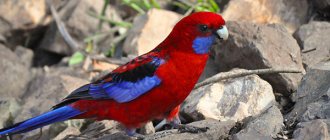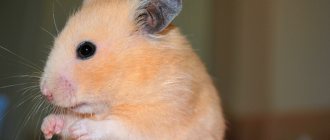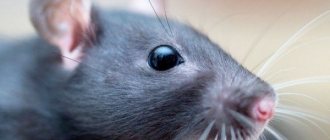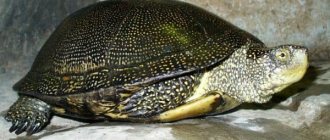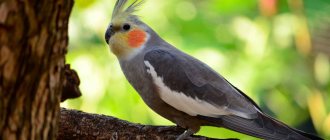- Wild animals
- >>
- Birds
The Gray parrot is a favorite pet bird for many.
He has unique abilities that distinguish him from most of his relatives. The modest coloring of the feathers is compensated by the skillful imitation of human speech and the sounds produced by many birds. Jaco learns more than a hundred words and phrases. However, even the healthiest and happiest pet creates a fair amount of clutter and noise. There are reports that Grays were kept as pets by the ancient Greeks, wealthy Romans, and even King Henry VIII and Portuguese sailors.
Origin of the species and description
Photo: Parrot zhkao
The gray parrot or gray parrot (Psittacus) is a genus of African parrots in the subfamily Psittacinae. It contains two species: the red-tailed parrot (P. erithacus) and the brown-tailed parrot (P. timneh).
Interesting fact: For many years, the two species of gray parrot were classified as subspecies of the same species. However, in 2012, BirdLife International recognized the taxa as distinct species based on genetic, morphological and vocal differences.
Gray parrots are found in primary and secondary tropical forests of West and Central Africa. This is one of the most intelligent bird species in the world. Their tendency to imitate speech and other sounds has made Grays popular as pets. The Gray parrot is important to the Yoruba people of Africa. Its feathers and tail are used to create masks worn during the religious and social festival in Geled.
Video: Gray parrot
The first recorded mention of the African gray parrot by Westerners occurred in 1402, when France occupied the Canary Islands, where the species had been introduced from Africa. As Portugal's trade relations with West Africa developed, more birds were captured and kept as pets. Gray parrot figures appear in paintings by Pieter Rubens in 1629/30, Jan Davids de Him in 1640–50 and Jan Steen 1663–65.
Maintenance at home
Despite the fact that the price of a gray parrot is very respectable, this species is very popular as a pet. It is best to buy a gray gray chick in a nursery or from a breeder, since the gray gray chick adapts faster to people and is initially tame (the link leads to a list of breeders and nurseries in Russia). This species is listed on Appendix 2 of CITES (Convention on International Trade in Endangered Species of Wild Fauna and Flora), which places restrictions on legal international trade in birds. You can legally export abroad only those birds that are caught in the wild within the framework of quotas, or those that are raised in a nursery and whose parents are parrots, which also have “legal” status.
Once the decision to become the owner of a gray parrot has been made, you need to think about where your future friend will live. An ideal cage for a Gray Gray should be durable and spacious (follow the link for detailed recommendations on choosing a cage). The minimum dimensions are usually called - 65 * 45 * 80 cm, and the general rule, regardless of whether you chose a fosterling Gray or a wild animal, is that the more spacious the apartment, the better. Considering the power of the beak, the diameter of the grille rod should be 2-3 mm or more. In Russia, the most popular cells are from the Chinese manufacturer Triol, as well as Italian FOP and Ferplast.
In nature, birds spend a significant part of their time searching and obtaining food, communicating with relatives, and they must also be constantly on alert due to the potential danger from predators. At home, external threats are practically reduced to zero, the feeder is always abundantly filled with food, and the drinking bowl is always filled with fresh water. It would seem that all the problems have been solved... However, a new problem appears - the brain of a highly intelligent parrot cannot remain idle. Boredom and inactivity lead to behavioral problems. Most often, according to reviews of gray parrots, this problem becomes self-plucking. To avoid self-plucking, the owner’s task is to provide constant physical and mental stress for the gray pet. There are two ways to provide a decent workout for the intelligence of your feathered pet:
- Provide him with plenty of toys and accessories. We recommend that you familiarize yourself with the material “toys for Grays”, where their types are discussed, examples are given, as well as recommendations for the selection of toys. One of the most important types are forage toys. Their principle is based on the interaction of a pet with fun, inside of which a treat is hidden. The parrot must perform some action (pull, press, yank, turn) in order to gain access to the tasty treat hidden inside. Forage toys stimulate the natural instinct of searching and obtaining food. The material also discusses other types of fun that help release energy and provide the necessary physical activity.
- The second way is daily training with a parrot. Teach him tricks, commands, and conversation. On the one hand, properly organized classes will be an exciting pastime for you and your pet, and will also provide him with intellectual and physical exercise, on the other hand, a talking gray parrot that can perform tricks will be a special pride for its owner.
Good content is a combination of both. If you become the owner of a fosterling, then it will be much easier to tame it to toys and daily activities. If the owner is an adult, then training and taming the Gray will require a lot of effort. However, regardless of the age of the Gray, you are obliged to provide him with physical and intellectual stress.
The next building block of proper maintenance is catering. The usual base is a grain mixture. By following the link you can get acquainted with the popular types of dry grain food for gray parrots. However, this is only one of the nutritional elements. A proper diet should include: greens and sprouted food, twig food, fruits, berries, vegetables, cereals and juices. Only a varied and correct diet will ensure the longevity of your bird.
Appearance and features
Photo: Talking gray parrot
There are two types:
- Red-tailed Parakeet (P. erithacus): This is a dominant species, larger than the Brown-tailed Parrot, measuring about 33 cm in length. A bird with light gray feathers, an all-black beak and a cherry-red tail. Young birds have darker, duller tails at the end until their first molt, which occurs at 18 months of age. These birds also initially have gray irises, which change color to pale yellow by the time the bird is a year old;
- The brown-tailed parrot (P. timneh) is slightly smaller in size than the red-tailed parrot, but the intelligence and speaking ability remain comparable. They can range from 22 to 28 cm in total length and are considered medium sized parakeets. The browntail has a darker charcoal gray coloration, a darker burgundy tail, and a light horn-like area toward part of the upper jaw. It is endemic to its range.
The brown-tailed gray usually begins to learn to speak earlier than the red-tailed gray, since the period of maturation occurs more quickly. These parrots have a reputation for being less nervous and sensitive than the red-tailed parrot.
Grays can learn to speak within the first year, but many do not say their first word until 12–18 months. Both subspecies appear to have the same ability and tendency to produce human speech, but vocal ability and propensity can vary widely among individual birds. Gray parrots tend to use more specific calls to different species. The most famous gray parrot is Nkisi, who had a vocabulary of over 950 words and was also known for his creative use of language.
Interesting fact: Some ornithologists recognize a third and fourth species, but they are difficult to distinguish in scientific DNA studies.
Intelligence
The Jaco parrot has unique intelligence and exceptional memory. Good learning ability, dynamic, observant and curious. She copes with tasks without much difficulty and does everything with great pleasure. Easily reproduces sounds and repeats intonation. Jaco's character is not an easy one. Females are calmer and more silent than males, who often behave more irritably.
Once in the home environment, he looks closely at those around him for a long time. The taming of the Jaco occurs gradually, adaptation to home conditions occurs quickly. Gradually begin to memorize words, short phrases, perform various tricks and tasks, try to make it more difficult each time. Dedicate to studying every day, but you need to have a lot of patience. The result will not keep you waiting. Learn and develop from 2 - 3 months.
Where does the gray parrot live?
Photo: Gray parrot
The habitats of African gray parrots cover the forest belt of Central and Western Africa, including the oceanic islands of Principe and Bioko (Gulf of Guinea), where they live in mountain forests at altitudes of up to 1900 m. In West Africa, they are found in coastal countries.
The Gray's habitat includes the following countries:
- Gabon;
- Angola;
- Ghana;
- Cameroon;
- Ivory Coast;
- Congo;
- Sierra Leone;
- Kenya;
- Uganda.
The two known subspecies of African gray parrots have different ranges. Psittacus Erithacus erithicus (Red-tailed Gray) inhabits a range extending from Kenya to the eastern border of Ivory Coast, including island populations. Psittacus Erithacus Timneh (Brown-tailed Gray) has a range from the eastern border of Ivory Coast to Guinea-Bissau.
The habitat of African gray parrots is moist lowland forests, although they are also found at altitudes of up to 2200 m in the eastern part of their range. They are usually observed at forest edges, clearings, gallery forests, mangroves, wooded savannas, crop fields and gardens.
Gray parrots often visit open lands adjacent to forested areas, they live in trees above water and prefer to roost on islands in rivers. They nest in tree hollows, sometimes choosing places left by birds. In West Africa, this species undergoes seasonal movements during the dry season.
Physical activity
Parrots love to “play” with the keyboard.
Only you will probably have to buy a new “toy”. Regular exercise and play is an important factor in maintaining your pet's physical and mental health. They help prevent stress and destructive behavior. You can equip the cage with various swings, perches, ladders and chains, as well as strong chewing toys. It is useful to constantly change toys and add something new.
What does a gray parrot eat?
Photo: Gray parrot from the Red Book
African gray parrots are herbivorous birds. In the wild, they learn a complex set of skills. The Grays learn how to separate healthy food plants from toxic ones, how to find safe water, and how to reunite with their families when they are separated. They eat mainly a variety of fruits, preferring the oil palm (Elaeis guinensis).
In the wild, Grays can eat the following foods:
- nuts;
- fruits;
- green leaves;
- snails;
- insects;
- succulent shoots;
- seeds;
- grains;
- bark;
- flowers.
Feeding sites, as a rule, are located at a considerable distance and are located on elevated plains. Birds often raid fields with unripe corn, which angers the field owners. They fly from tree to tree, trying to find more ripe fruits and nuts. Grays prefer to climb branches rather than fly.
Interesting Fact: In captivity, the bird can eat bird pellets, a variety of fruits such as pear, orange, pomegranate, apple and banana, and vegetables such as carrots, boiled sweet potatoes, celery, cucumbers, fresh cabbage, peas and green beans. In addition, the Gray needs a source of calcium.
Gray parrots partly feed on the ground, so there are a number of behaviors that birds go through before perching and safely consuming food. Groups of parrots gather around a barren tree until it is completely filled with hundreds of birds preening their feathers, climbing branches, making sounds and communicating. Then the birds descend in waves to the ground. The entire group is never on the ground at the same time. Once on the ground, they are extremely alert, reacting to any movement or sound.
Now you know what a gray parrot eats, let's see how it lives in its natural environment.
Price
Many people wonder: how to choose a Gray and how much does it cost? Pets live on average from fifty to sixty years, so when you buy a pet, you are buying a friend for life.
Thanks to their talents, birds are very popular. There is a brown-tailed species and a red-tailed one, their cost differs significantly, due to what the species looks like. So, untrained speech in the market or on the Internet through various advertisements can be purchased for 15 - 35 thousand rubles.
It all also depends on where you purchase the animal. The cost is higher in a pet store, where their price is approximately seventy to one hundred and fifty thousand rubles. They usually have their own catalog, which can be viewed online.
Breeders have fosterlings in the price range from sixty to one hundred and twenty thousand rubles. Even those who can speak and are quite old cost from three hundred thousand rubles and even more. Don’t forget to include in the price what you will feed your pet.
Next
Gray Red-tailed Gray and all information and breed
Features of character and lifestyle
Photo: Domestic gray parrot
Wild African Gray parrots are very shy and rarely allow people to approach them. They are social birds and nest in large groups. They are often seen in noisy flocks, calling loudly in the mornings, evenings and in flight. The flocks consist only of gray parrots, unlike other parrot species which are found in mixed flocks. During the day, they break up into small groups and fly long distances to forage.
Grays live in trees above water and prefer to spend the night on river islands. Young birds remain in their family groups for long periods of time, up to several years. They socialize with others of their age in nursery trees, but stick to their family pack. Young parrots are looked after by older birds until they are educated and mature enough to live on their own.
Interesting fact: Young Grays exhibit respectful behavior towards older members of the pack. They learn how to behave in different situations, such as competition and defense of nest sites and raising offspring. Competition for nests during the mating season makes the species extremely aggressive.
Birds go to roost at dusk and even in the dark. They travel their way along established routes, carrying out fast and direct flights, often flapping their wings. Previously, roosting flocks were huge, often numbering up to 10,000 parrots. Early in the morning, before sunrise, small flocks leave their roosting area and go screaming to feed.
Causes of death
A common cause of the premature death of Jaco is errors in maintenance that lead to the pet's illness. Self-medication and delaying the moment of contacting an ornithologist greatly reduce the likelihood of a favorable outcome for the parrot.
There are also frequent cases of poisoning, as well as death of birds from accidents. In order for your pet to live a long and happy life, it is necessary to take timely preventive measures to prevent diseases, monitor the behavior of your feathered friend and, at the slightest sign of ill health, consult a specialist.
Social structure and reproduction
Photo: Gray parrot
African Gray parrots are very social birds. Reproduction occurs in free colonies, each pair occupying its own tree. Individuals carefully select their mates and have a lifelong monogamous relationship that begins at sexual maturity, between the ages of three and five. Little is known about courtship in the wild, but observational flights around nests have been observed and recorded.
Interesting fact: Males feed their mate (nuptial feeding) and both produce soft monotonous sounds. During this time, the female will sleep in the nest, and the male will guard it. In captivity, males feed females after copulation, and both sexes engage in a mating dance in which they lower their wings.
The breeding season varies depending on the area, but appears to coincide with the dry season. African gray parrots breed once to twice a year. Females lay three to five round eggs, one at an interval of 2 to 5 days. The females incubate the eggs and feed entirely on the food brought by the male. Incubation takes about thirty days. The chicks leave the nest at the age of twelve weeks.
After the young chicks leave the nest, both parents continue to feed, raise and protect them. They care for their offspring for several years until they become independent. Life expectancy is 40 to 50 years. In captivity, African gray parrots have an average lifespan of 45 years, but can live up to 60 years. In the wild - 22.7 years.
Answers to frequently asked questions about gray parrots
Which floor is better?
Some sources like to point out that males have better speaking abilities. It is not true. Gender doesn't matter. As with people, the personal characteristics of the bird are much more important.
At what age can you buy a chick?
Most parrot breeders advise buying at 3-4 months of age. At this age, the nursing chicks are completely emancipated, but at the same time obedient and interested in interacting with people. Although there are other opinions. For example, the Italian nursery Centro de Cria PSITTACUS recommends taking it at 70 days of age. This is explained by the fact that at this age the most important stage of development begins - socialization, which determines the future behavior of the parrot. But at this age, the chicks will have to be fed manually for some time.
Parrots and children
Parrots are social birds; interaction with other members of the article is a natural element of life for them. If you realize that any living creature is not a toy, and are able to provide it with proper care, attention and control, then such a neighborhood is quite acceptable. Some are afraid of the bird's jealousy in a situation if the child was born after the appearance of the bird. In this case, in order to avoid jealousy and other difficulties, you will have to be especially sensitive - provide your winged friend with the same care and attention, teach your child how to properly communicate with your pet.
Other animals
From our point of view, such a neighborhood carries a potential danger and it is better that it does not exist. Although it is worth noting that there are many examples of peaceful cohabitation of a large parrot with dogs and cats (including from reputable breeders).
Is it possible to leave a bird alone in a room?
Our apartment contains a lot of potential dangers - indoor plants (some of them are poisonous), electrical wires and sockets, household appliances, wallpaper. Some owners adapt the room directly for the winged pet, which makes it safe even in the absence of people. Otherwise, such walks carry risks.
How to determine gender?
Experienced breeders are able to determine the sex with a fairly high degree of accuracy based on some visual signs - head shape, shades of color. However, the most reliable way to determine gender is DNA analysis.
Is it normal for white powder to appear on feathers?
Yes, good. This powder helps keep feathers in good condition. Just wash your pet regularly (with a spray bottle, for example) to control the amount of powder on the wings.
Is food from our table acceptable?
Gray parrots, being flocking birds, will try to taste what you eat. This is unacceptable, because most human food is dangerous for them. The best solution in such a situation would be to switch attention from human food to safe and healthy food, for example, putting it on the same plate as yours.
Seasonality of food
In nature, the diet of birds varies depending on the time of year. Changing your diet is an integral part of your diet. Therefore, it is completely normal if in summer you offer some types of fruits that are in abundance in summer, and in winter other types.
Do I need to clip my wings?
Definitely not! Flight helps give the bird the necessary physical activity that cannot be obtained in any other way, and it also helps to learn to control and coordinate its movements. In addition, wing clipping can contribute to behavioral problems.
How to properly cage?
From the first day, it is necessary to properly train the Gray to enter the cage.
What not to do:
- forced to return to the cage by force, caught with a towel or wearing protective gloves;
- lure by putting a treat inside.
What do we have to do:
- be willing to spend time learning;
- regularly carry it on your hand into the cage, but without closing it;
- tame to the team for independent entry (for example, “home”);
- when following a command, emotionally praise and reward with a treat;
- after entering the cage, stay next to it for some time and communicate with the parrot.
Will he talk?
Almost every owner wants a talking gray parrot and asks the question: will his pet talk? This species has excellent abilities to learn human speech. We recommend that you read the material “how to teach a parrot to talk,” which provides useful recommendations for teaching conversation. Imitating sounds is a natural behavior for most parrots. If your pet feels like a member of the family and actively participates in family life, then its motivation to learn will be maximum.
How to deal with screaming?
What not to do:
- scold, shout back at him;
- lose patience and react when the bird screams long and persistently.
What do we have to do:
- ignore the scream;
- if the winged one behaves as it should, then praise it, reward it, show that you are satisfied;
- spend time working with your pet when he is calm.
How often do you visit the veterinarian?
It is best to make such visits annually. Regular visits to an experienced veterinarian will help detect abnormalities and problems, which means timely action can be taken.
Natural enemies of gray parrots
Photo: Gray parrot
In nature, gray parrots have few enemies. They receive the main damage from humans. Previously, local tribes killed birds for meat. West Africans believed in the magical properties of red feathers, so Grays were also destroyed for their feathers. Later, parrots began to be caught for sale. Grays are secretive, cautious birds, so it is difficult to catch an adult. The Aborigines willingly caught fledgling chicks in the net to generate income.
The gray eagle's enemy is the palm eagle or vulture (Gypohierax angolensis). The diet of this predator mainly consists of oil palm fruits. It is possible that the eagle's aggressive behavior towards the Gray Gray has a competitive significance due to food. You can watch gray parrots scatter in panic in different directions, attacked by an eagle. This was probably the protection of the feeding area by the eagle.
Natural predators for this species include:
- vultures;
- palm eagle;
- monkeys;
- hawks
Adult birds teach their offspring how to defend their territory and how to recognize and avoid predators. By feeding on the ground, African gray parrots are vulnerable to terrestrial predators. Monkeys hunt for eggs and young chicks in the nest. Several species of hawks also prey on chicks and adults. It has been found that gray parrots in captivity are susceptible to fungal infections, bacterial infections, malignant tumors, beak and feather diseases, and can become infected with tapeworms and worms.
What do young parrots look like?
Gray Gray chicks have almost black irises. The skin around the eye sockets and on the paws is thin, smooth, and pink in color. The white edging of the feathers is still missing. The feathers can be milky or beige; under the tail they are not yet bright red, but dark, as if dirty.
As soon as the Gray chick becomes older than 8 months, its iris will lighten and later become bright yellow. This will happen in the third year of life. Gray chicks with gray, whitish, smoky eyes are young parrots up to 2 years old.
On a note! Gray chicks up to 1 year old are suitable for taming and training. They make contact more easily, remember new words faster, and their character is more flexible.
The plumage of Gray Gray chicks is pale gray, dirty beige, and inconspicuous. Gradually, by about a year or two, it will acquire the ash-gray color with white streaks typical of an adult.
Population and species status
Photo: Gray parrot
A recent analysis of Gray Gray populations showed the bird's dismal situation in the wild. Up to 21% of the world's population is captured annually. Unfortunately, there is no law prohibiting the capture and trade of parrots. In addition, the numbers of these birds are affected by habitat destruction, indiscriminate use of pesticides and hunting by local residents. The wild bird trade trap is the main cause of the decline in wild African gray parrot populations.
Interesting fact: Estimates of the total wild gray population at the beginning of the 21st century have varied as high as 13 million, although accurate surveys have been impossible because the parrots live in isolated, often politically unstable regions.
The Gray Gray species is endemic to the primary and secondary tropical forests of West and Central Africa. These parrots depend on large old trees with natural cavities, which are used by the grays for nesting. Studies in Guinea and Guinea-Bissau have shown that the relationship between species status and primary forest condition is proportionate where forests are declining, and so are gray parrot populations.
In addition, the Gray Gray is one of the hyper-traded bird species registered in CITES. In response to continued population declines, overharvest quotas, and unsustainable and illegal trade, CITES included the gray parrot in Phase VI of the CITES Significant Trade Review in 2004. This review led to recommended zero export quotas for some range countries and the decision to develop regional management plans for the species.
Artificially eaten subspecies
Currently, there are many more subspecies of gray parrots than exist in nature. All of them were bred artificially by ornithologists.
Here are some of the new subspecies of the African gray bird:
- Gray-pink are parrots whose feather edges are pink rather than white.
- Albinos are completely white individuals.
- Yellow birds are lutinos. Their plumage is pale yellow, almost beige.
These birds can be purchased at any reputable nursery. Ornamental parrots of the yellow gray breed look bright and unusual.
The gray parrot is an exotic bird with a difficult character. If you purchase a young specimen and give it enough time and attention, you can raise an intelligent and devoted friend who will delight you with his company for many years.



